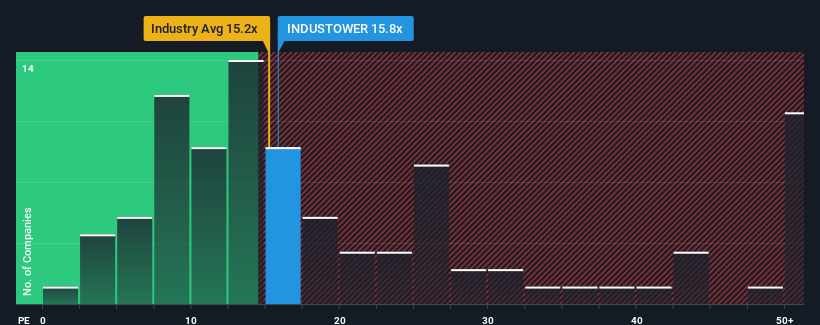- India
- /
- Telecom Services and Carriers
- /
- NSEI:INDUSTOWER
Indus Towers Limited (NSE:INDUSTOWER) Surges 28% Yet Its Low P/E Is No Reason For Excitement

Despite an already strong run, Indus Towers Limited (NSE:INDUSTOWER) shares have been powering on, with a gain of 28% in the last thirty days. The last month tops off a massive increase of 131% in the last year.
Although its price has surged higher, Indus Towers' price-to-earnings (or "P/E") ratio of 15.8x might still make it look like a buy right now compared to the market in India, where around half of the companies have P/E ratios above 32x and even P/E's above 58x are quite common. Although, it's not wise to just take the P/E at face value as there may be an explanation why it's limited.
Recent times have been advantageous for Indus Towers as its earnings have been rising faster than most other companies. One possibility is that the P/E is low because investors think this strong earnings performance might be less impressive moving forward. If you like the company, you'd be hoping this isn't the case so that you could potentially pick up some stock while it's out of favour.
See our latest analysis for Indus Towers

Is There Any Growth For Indus Towers?
There's an inherent assumption that a company should underperform the market for P/E ratios like Indus Towers' to be considered reasonable.
Taking a look back first, we see that the company grew earnings per share by an impressive 126% last year. Pleasingly, EPS has also lifted 32% in aggregate from three years ago, thanks to the last 12 months of growth. Accordingly, shareholders would have probably welcomed those medium-term rates of earnings growth.
Turning to the outlook, the next three years should generate growth of 3.5% per year as estimated by the analysts watching the company. Meanwhile, the rest of the market is forecast to expand by 19% each year, which is noticeably more attractive.
With this information, we can see why Indus Towers is trading at a P/E lower than the market. Apparently many shareholders weren't comfortable holding on while the company is potentially eyeing a less prosperous future.
The Final Word
Indus Towers' stock might have been given a solid boost, but its P/E certainly hasn't reached any great heights. Using the price-to-earnings ratio alone to determine if you should sell your stock isn't sensible, however it can be a practical guide to the company's future prospects.
We've established that Indus Towers maintains its low P/E on the weakness of its forecast growth being lower than the wider market, as expected. Right now shareholders are accepting the low P/E as they concede future earnings probably won't provide any pleasant surprises. Unless these conditions improve, they will continue to form a barrier for the share price around these levels.
A lot of potential risks can sit within a company's balance sheet. You can assess many of the main risks through our free balance sheet analysis for Indus Towers with six simple checks.
If P/E ratios interest you, you may wish to see this free collection of other companies with strong earnings growth and low P/E ratios.
New: AI Stock Screener & Alerts
Our new AI Stock Screener scans the market every day to uncover opportunities.
• Dividend Powerhouses (3%+ Yield)
• Undervalued Small Caps with Insider Buying
• High growth Tech and AI Companies
Or build your own from over 50 metrics.
Have feedback on this article? Concerned about the content? Get in touch with us directly. Alternatively, email editorial-team (at) simplywallst.com.
This article by Simply Wall St is general in nature. We provide commentary based on historical data and analyst forecasts only using an unbiased methodology and our articles are not intended to be financial advice. It does not constitute a recommendation to buy or sell any stock, and does not take account of your objectives, or your financial situation. We aim to bring you long-term focused analysis driven by fundamental data. Note that our analysis may not factor in the latest price-sensitive company announcements or qualitative material. Simply Wall St has no position in any stocks mentioned.
About NSEI:INDUSTOWER
Indus Towers
A telecom infrastructure company, engages in the operation and maintenance of wireless communication towers and related infrastructures for various telecom service providers in India.
Outstanding track record with excellent balance sheet.
Similar Companies
Market Insights
Community Narratives




